Abstract
Genomic amplification followed by direct sequencing enabled us to establish the causative mutation in 67 unrelated hemophilia B patients of predominantly German origin. With the detection of the mutation, extensive pedigree analysis has become feasible. We therefore anticipated that determination of the origin of mutation could be achieved in a comparatively great number of families. Although these investigations often were restricted by the availability of blood samples from the maternal grandparents or great-grandparents, we were able to prove a de novo mutation in 9 of 20 families with sporadic hemophilia B and in 3 of 20 families with a history of the disease. This could be achieved with the aid of RFLP analysis and, in one case, where the mutation is still unknown, with the aid of biochemical and immunological factor IX assays. Since the maternal grandfather was decreased in two of these families, the germ line of origin could not be determined precisely. In the remaining families, the female and male germ lines turned out to be the origin of mutation in six and four cases, respectively, and an effect of paternal age on the mutations observed could not be excluded. Furthermore, our data indicate that the hemophilia B gene pool is mainly renewed by variable mutations.
Full text
PDF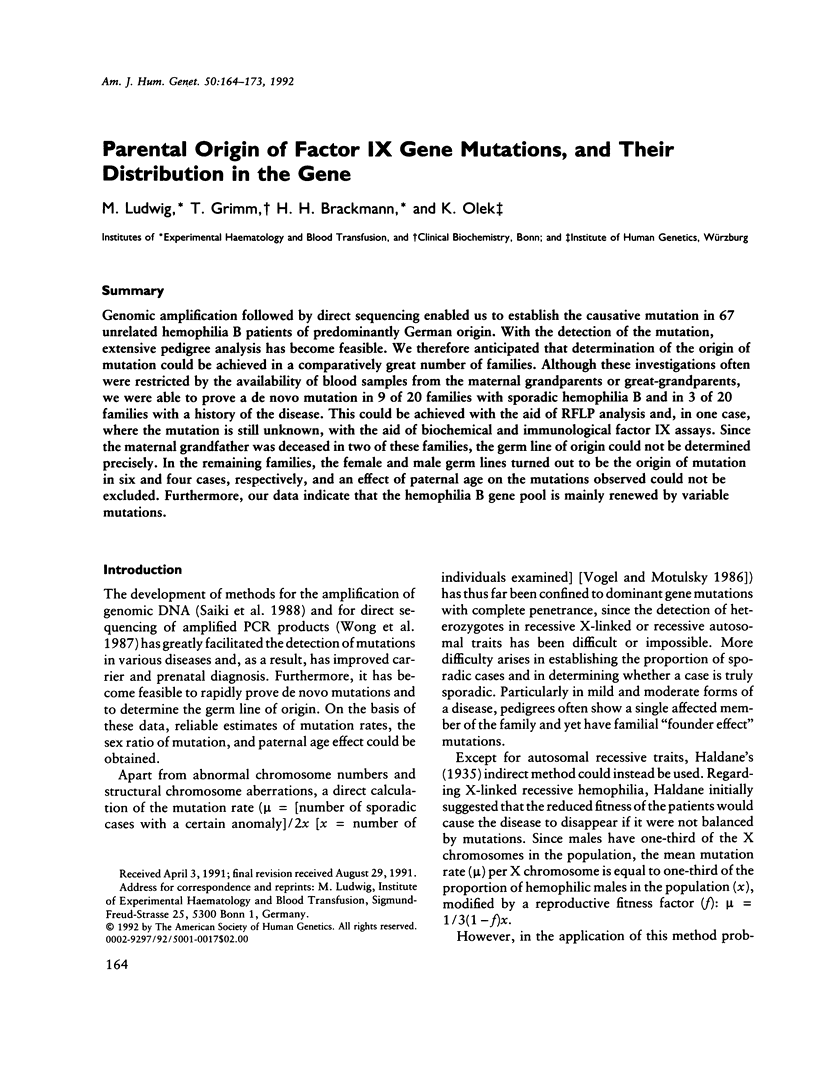
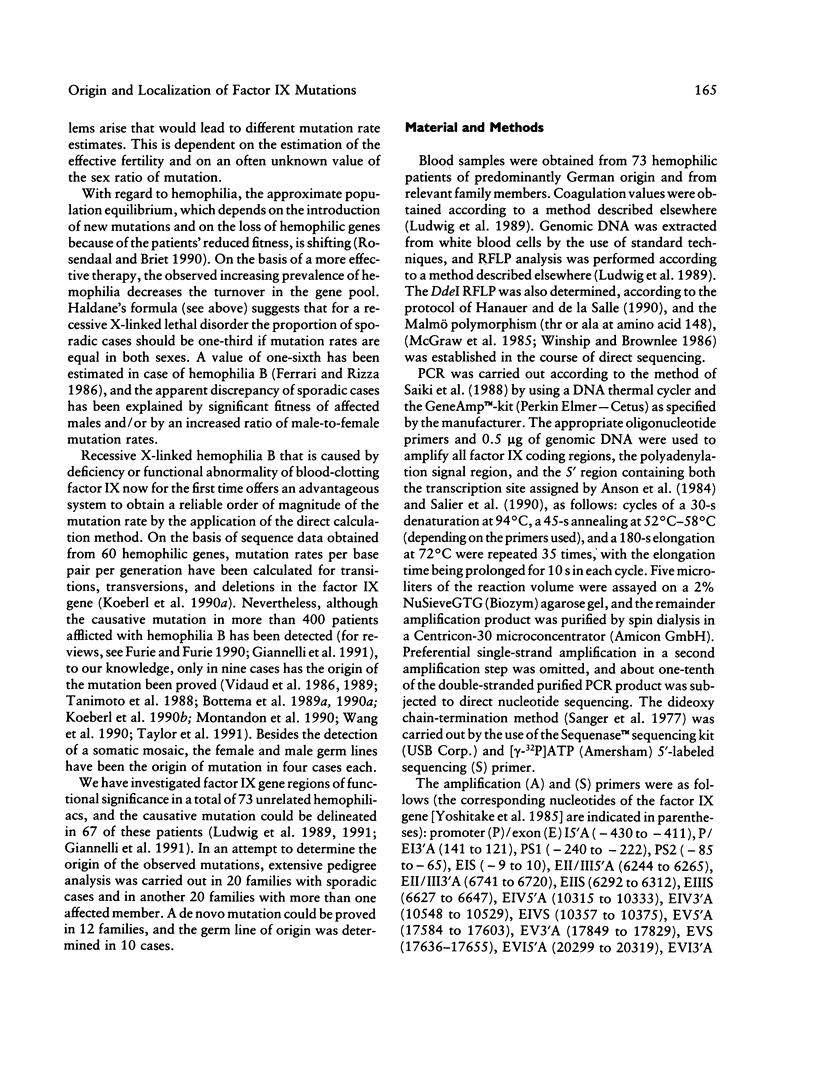
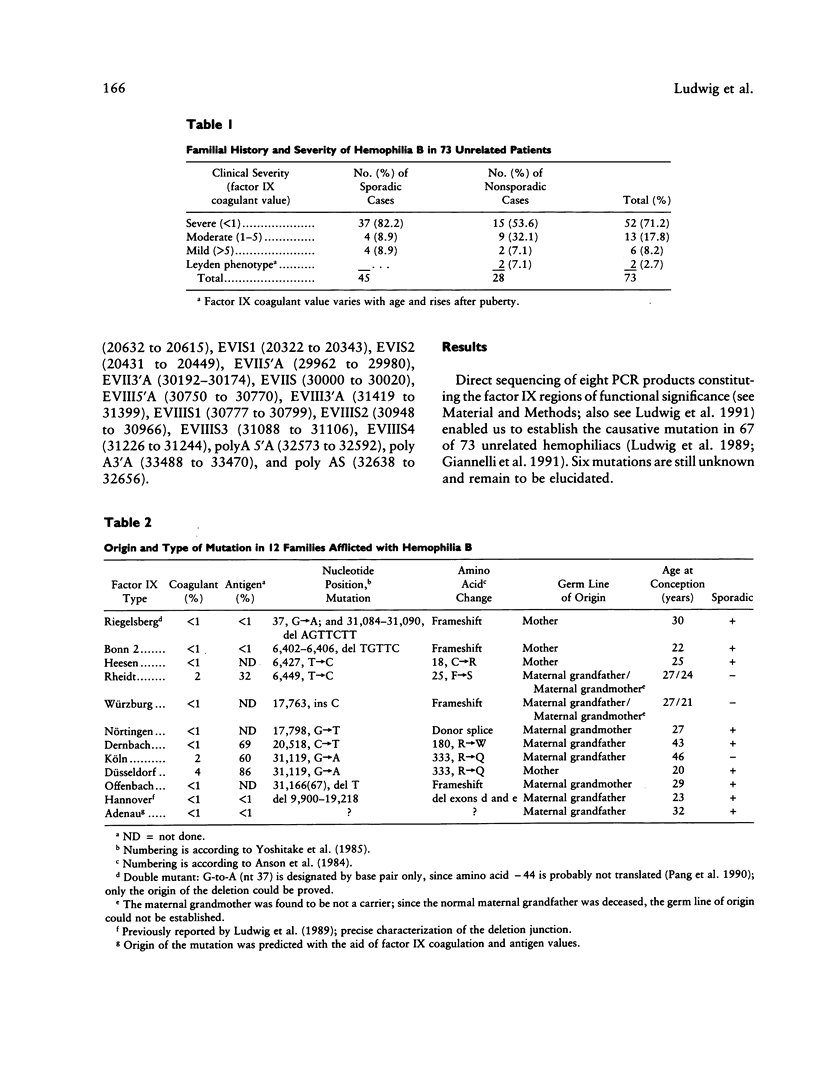
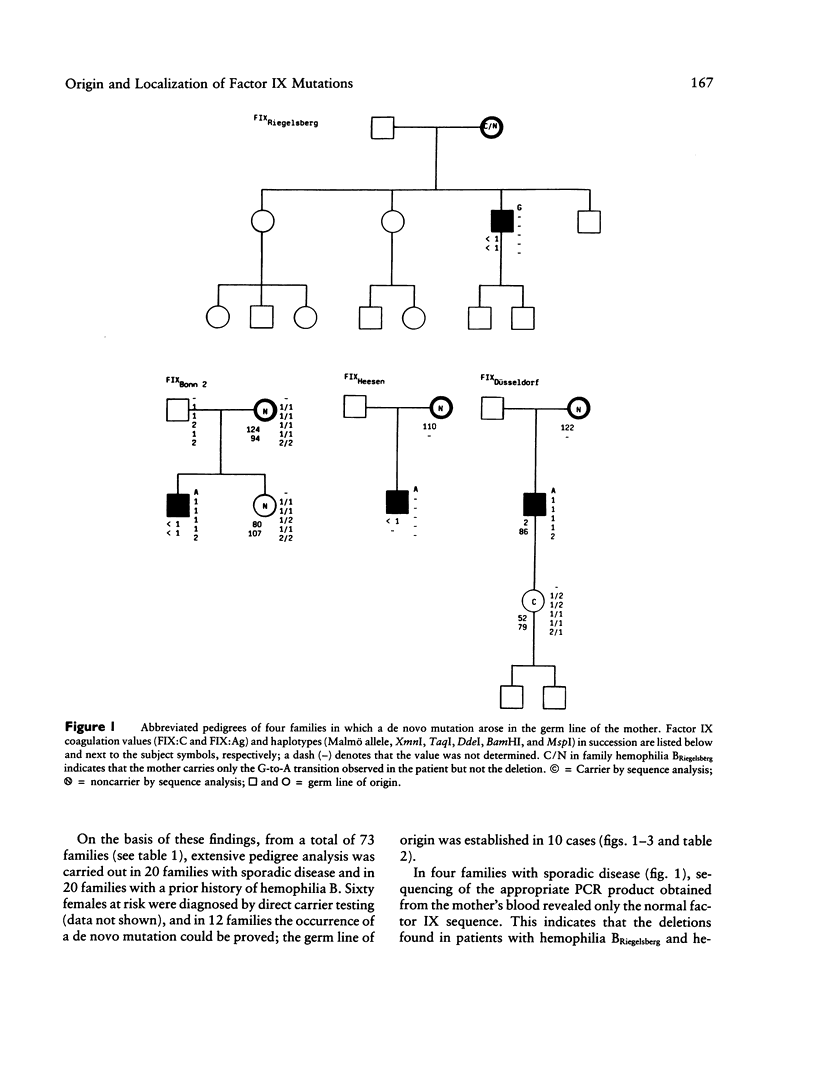
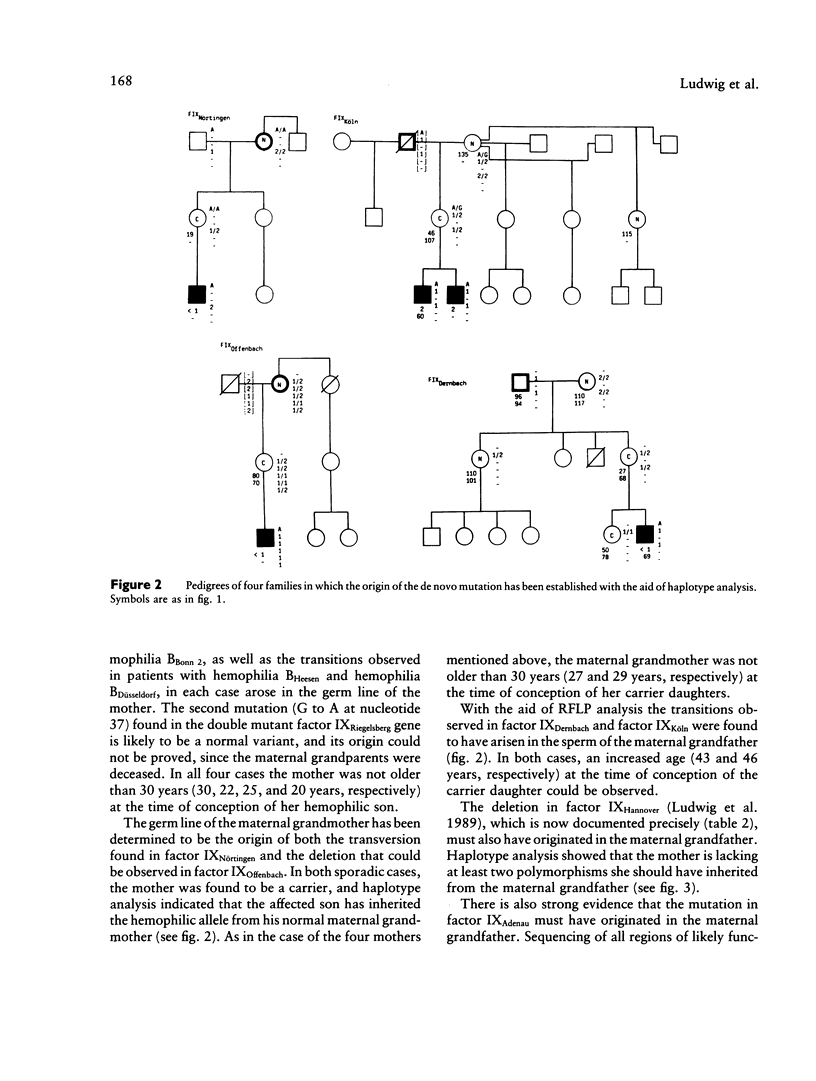
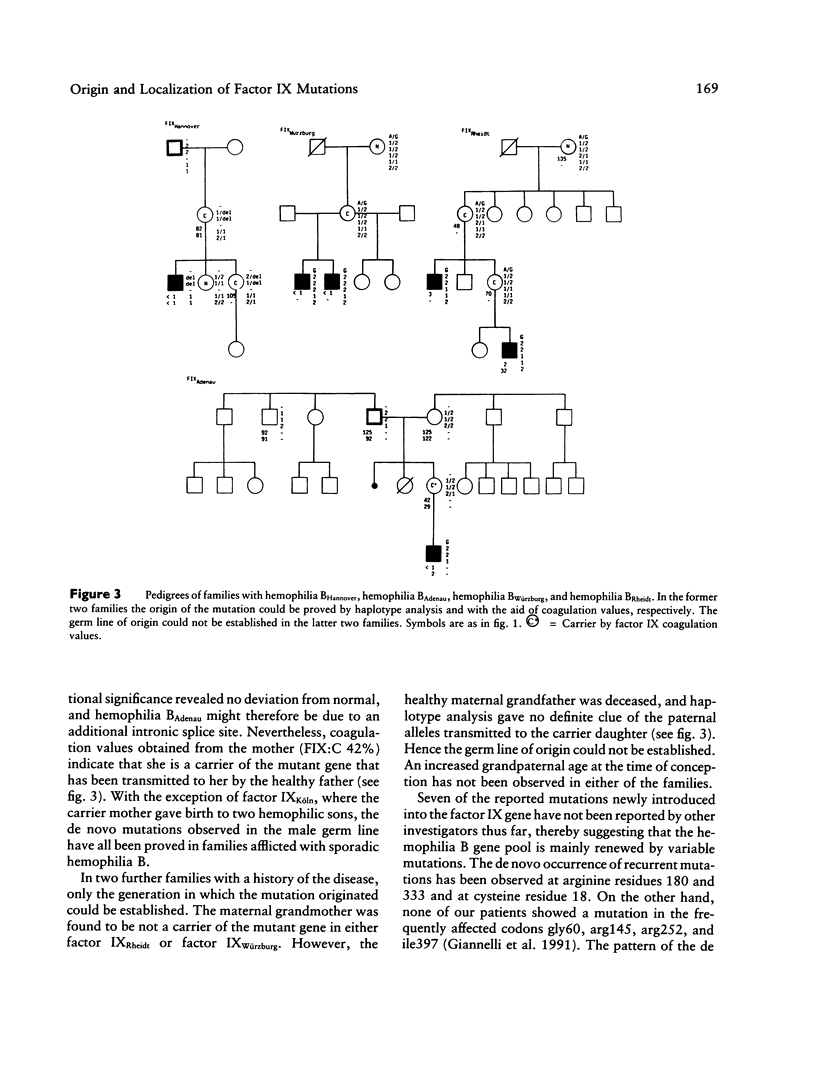
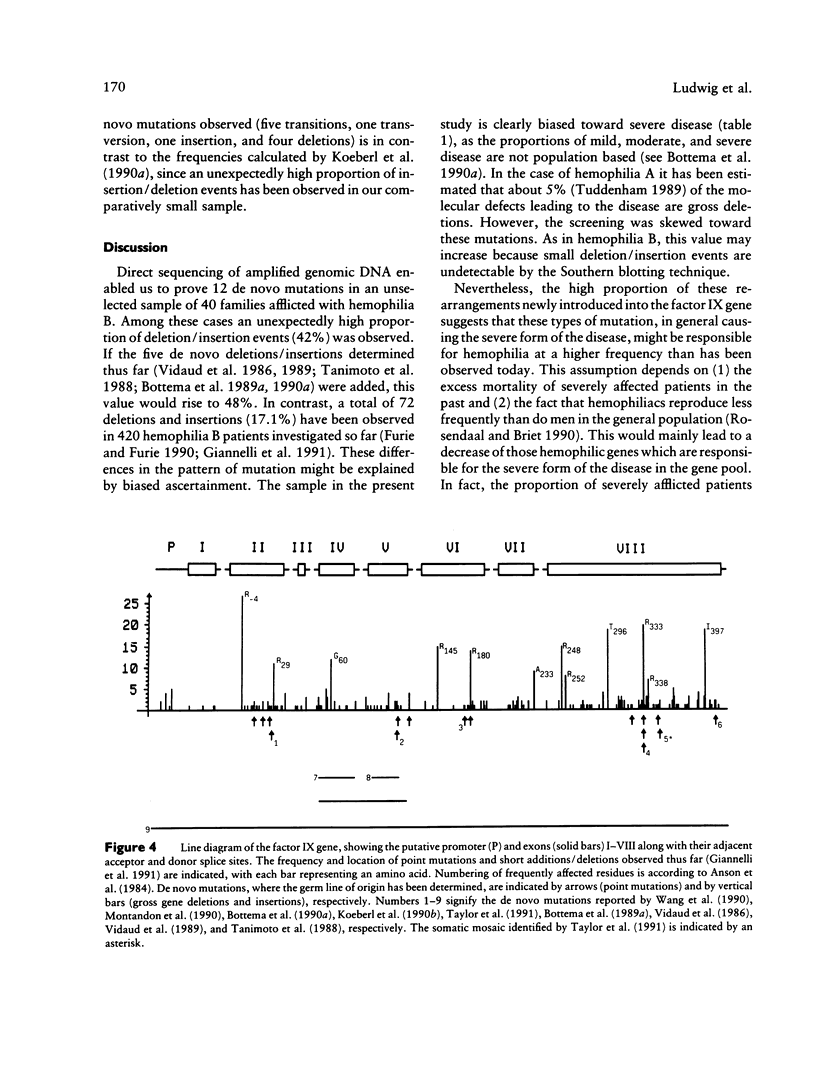
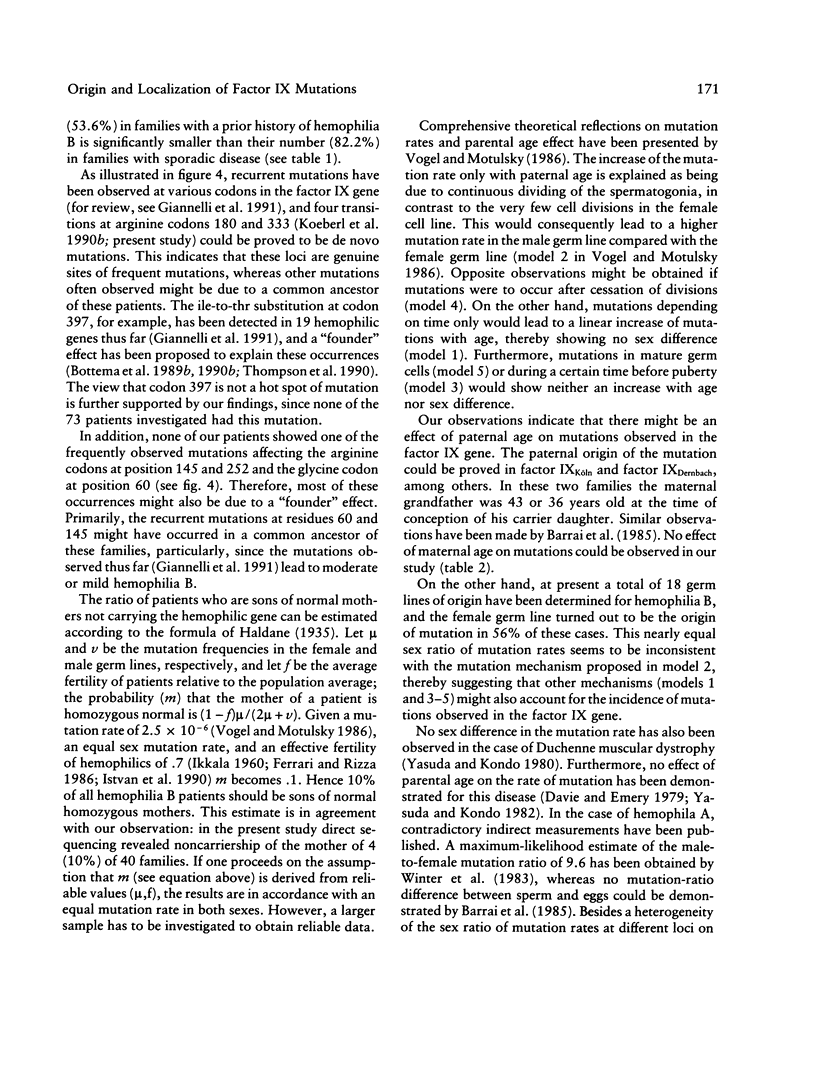
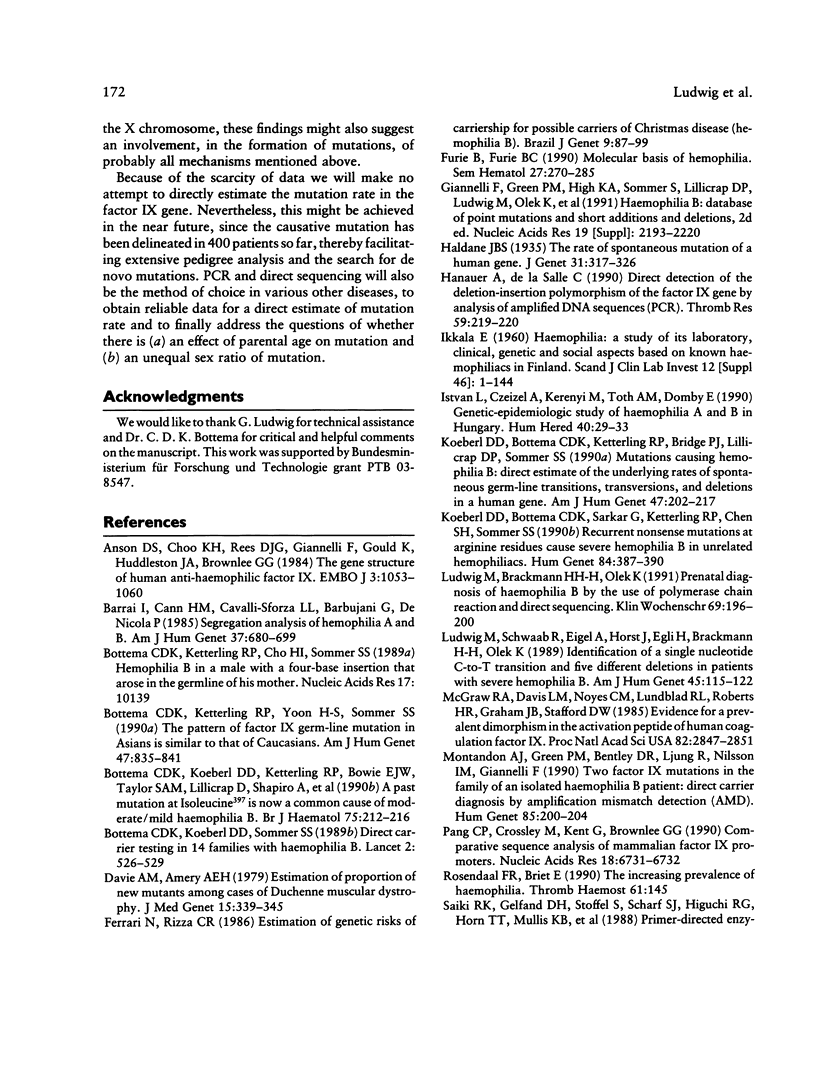
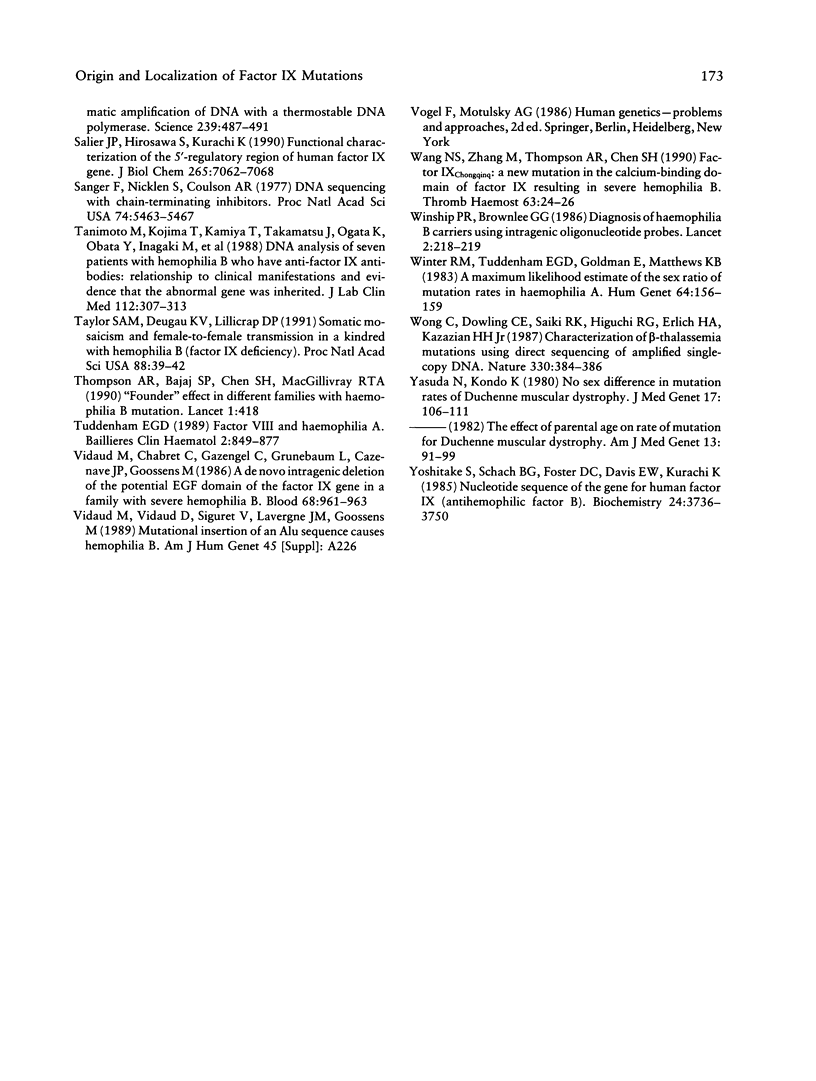
Selected References
These references are in PubMed. This may not be the complete list of references from this article.
- Anson D. S., Choo K. H., Rees D. J., Giannelli F., Gould K., Huddleston J. A., Brownlee G. G. The gene structure of human anti-haemophilic factor IX. EMBO J. 1984 May;3(5):1053–1060. doi: 10.1002/j.1460-2075.1984.tb01926.x. [DOI] [PMC free article] [PubMed] [Google Scholar]
- Barrai I., Cann H. M., Cavalli-Sforza L. L., Barbujani G., De Nicola P. Segregation analysis of hemophilia A and B. Am J Hum Genet. 1985 Jul;37(4):680–699. [PMC free article] [PubMed] [Google Scholar]
- Bottema C. D., Ketterling R. P., Cho H. I., Sommer S. S. Hemophilia B in a male with a four-base insertion that arose in the germline of his mother. Nucleic Acids Res. 1989 Dec 11;17(23):10139–10139. doi: 10.1093/nar/17.23.10139. [DOI] [PMC free article] [PubMed] [Google Scholar]
- Bottema C. D., Ketterling R. P., Yoon H. S., Sommer S. S. The pattern of factor IX germ-line mutation in Asians is similar to that of Caucasians. Am J Hum Genet. 1990 Nov;47(5):835–841. [PMC free article] [PubMed] [Google Scholar]
- Bottema C. D., Koeberl D. D., Ketterling R. P., Bowie E. J., Taylor S. A., Lillicrap D., Shapiro A., Gilchrist G., Sommer S. S. A past mutation at isoleucine 397 is now a common cause of moderate/mild haemophilia B. Br J Haematol. 1990 Jun;75(2):212–216. doi: 10.1111/j.1365-2141.1990.tb02651.x. [DOI] [PubMed] [Google Scholar]
- Bottema C. D., Koeberl D. D., Sommer S. S. Direct carrier testing in 14 families with haemophilia B. Lancet. 1989 Sep 2;2(8662):526–529. doi: 10.1016/s0140-6736(89)90653-3. [DOI] [PubMed] [Google Scholar]
- Davie A. M., Emery A. E. Estimation of proportion of new mutants among cases of Duchenne muscular dystrophy. J Med Genet. 1978 Oct;15(5):339–345. doi: 10.1136/jmg.15.5.339. [DOI] [PMC free article] [PubMed] [Google Scholar]
- Furie B., Furie B. C. Molecular basis of hemophilia. Semin Hematol. 1990 Jul;27(3):270–285. [PubMed] [Google Scholar]
- Giannelli F., Green P. M., High K. A., Sommer S., Lillicrap D. P., Ludwig M., Olek K., Reitsma P. H., Goossens M., Yoshioka A. Haemophilia B: database of point mutations and short additions and deletions--second edition. Nucleic Acids Res. 1991 Apr 25;19 (Suppl):2193–2219. doi: 10.1093/nar/19.suppl.2193. [DOI] [PMC free article] [PubMed] [Google Scholar]
- Hanauer A., de la Salle C. Direct detection of the deletion-insertion polymorphism of the factor IX gene by analysis of amplified DNA sequences (PCR). Thromb Res. 1990 Jul 1;59(1):219–220. doi: 10.1016/0049-3848(90)90287-m. [DOI] [PubMed] [Google Scholar]
- IKKALA E. Haemophilia. A study of its laboratory, clinical, genetic and social aspects based on known haemophiliacs in Finland. Scalpel (Brux) 1960;12(Suppl 46):1–144. [PubMed] [Google Scholar]
- István L., Czeizel A., Kerényi M., Tóth A. M., Domby E. Genetic-epidemiologic study of haemophilia A and B in Hungary. Hum Hered. 1990;40(1):29–33. doi: 10.1159/000153898. [DOI] [PubMed] [Google Scholar]
- Koeberl D. D., Bottema C. D., Ketterling R. P., Bridge P. J., Lillicrap D. P., Sommer S. S. Mutations causing hemophilia B: direct estimate of the underlying rates of spontaneous germ-line transitions, transversions, and deletions in a human gene. Am J Hum Genet. 1990 Aug;47(2):202–217. [PMC free article] [PubMed] [Google Scholar]
- Ludwig M., Brackmann H. H., Olek K. Prenatal diagnosis of haemophilia B by the use of polymerase chain reaction and direct sequencing. Klin Wochenschr. 1991 Mar 18;69(5):196–200. doi: 10.1007/BF01646940. [DOI] [PubMed] [Google Scholar]
- Ludwig M., Schwaab R., Eigel A., Horst J., Egli H., Brackmann H. H., Olek K. Identification of a single nucleotide C-to-T transition and five different deletions in patients with severe hemophilia B. Am J Hum Genet. 1989 Jul;45(1):115–122. [PMC free article] [PubMed] [Google Scholar]
- McGraw R. A., Davis L. M., Noyes C. M., Lundblad R. L., Roberts H. R., Graham J. B., Stafford D. W. Evidence for a prevalent dimorphism in the activation peptide of human coagulation factor IX. Proc Natl Acad Sci U S A. 1985 May;82(9):2847–2851. doi: 10.1073/pnas.82.9.2847. [DOI] [PMC free article] [PubMed] [Google Scholar]
- Montandon A. J., Green P. M., Bentley D. R., Ljung R., Nilsson I. M., Giannelli F. Two factor IX mutations in the family of an isolated haemophilia B patient: direct carrier diagnosis by amplification mismatch detection (AMD). Hum Genet. 1990 Jul;85(2):200–204. doi: 10.1007/BF00193196. [DOI] [PubMed] [Google Scholar]
- Pang C. P., Crossley M., Kent G., Brownlee G. G. Comparative sequence analysis of mammalian factor IX promoters. Nucleic Acids Res. 1990 Nov 25;18(22):6731–6732. doi: 10.1093/nar/18.22.6731. [DOI] [PMC free article] [PubMed] [Google Scholar]
- Rosendaal F. R., Briët E. The increasing prevalence of haemophilia. Thromb Haemost. 1990 Feb 19;63(1):145–145. [PubMed] [Google Scholar]
- Saiki R. K., Gelfand D. H., Stoffel S., Scharf S. J., Higuchi R., Horn G. T., Mullis K. B., Erlich H. A. Primer-directed enzymatic amplification of DNA with a thermostable DNA polymerase. Science. 1988 Jan 29;239(4839):487–491. doi: 10.1126/science.2448875. [DOI] [PubMed] [Google Scholar]
- Salier J. P., Hirosawa S., Kurachi K. Functional characterization of the 5'-regulatory region of human factor IX gene. J Biol Chem. 1990 Apr 25;265(12):7062–7068. [PubMed] [Google Scholar]
- Sanger F., Nicklen S., Coulson A. R. DNA sequencing with chain-terminating inhibitors. Proc Natl Acad Sci U S A. 1977 Dec;74(12):5463–5467. doi: 10.1073/pnas.74.12.5463. [DOI] [PMC free article] [PubMed] [Google Scholar]
- Tanimoto M., Kojima T., Kamiya T., Takamatsu J., Ogata K., Obata Y., Inagaki M., Iizuka A., Nagao T., Kurachi K. DNA analysis of seven patients with hemophilia B who have anti-factor IX antibodies: relationship to clinical manifestations and evidence that the abnormal gene was inherited. J Lab Clin Med. 1988 Sep;112(3):307–313. [PubMed] [Google Scholar]
- Taylor S. A., Deugau K. V., Lillicrap D. P. Somatic mosaicism and female-to-female transmission in a kindred with hemophilia B (factor IX deficiency). Proc Natl Acad Sci U S A. 1991 Jan 1;88(1):39–42. doi: 10.1073/pnas.88.1.39. [DOI] [PMC free article] [PubMed] [Google Scholar]
- Thompson A. R., Bajaj S. P., Chen S. H., MacGillivray R. T. "Founder" effect in different families with haemophilia B mutation. Lancet. 1990 Feb 17;335(8686):418–418. doi: 10.1016/0140-6736(90)90259-8. [DOI] [PubMed] [Google Scholar]
- Tuddenham E. G. Factor VIII and haemophilia A. Baillieres Clin Haematol. 1989 Oct;2(4):849–877. doi: 10.1016/s0950-3536(89)80049-6. [DOI] [PubMed] [Google Scholar]
- Vidaud M., Chabret C., Gazengel C., Grunebaum L., Cazenave J. P., Goossens M. A de novo intragenic deletion of the potential EGF domain of the factor IX gene in a family with severe hemophilia B. Blood. 1986 Oct;68(4):961–963. [PubMed] [Google Scholar]
- Wang N. S., Zhang M., Thompson A. R., Chen S. H. Factor IX Chongqing: a new mutation in the calcium-binding domain of factor IX resulting in severe hemophilia B. Thromb Haemost. 1990 Feb 19;63(1):24–26. [PubMed] [Google Scholar]
- Winship P. R., Brownlee G. G. Diagnosis of haemophilia B carriers using intragenic oligonucleotide probes. Lancet. 1986 Jul 26;2(8500):218–219. doi: 10.1016/s0140-6736(86)92513-4. [DOI] [PubMed] [Google Scholar]
- Winter R. M., Tuddenham E. G., Goldman E., Matthews K. B. A maximum likelihood estimate of the sex ratio of mutation rates in haemophilia A. Hum Genet. 1983;64(2):156–159. doi: 10.1007/BF00327115. [DOI] [PubMed] [Google Scholar]
- Wong C., Dowling C. E., Saiki R. K., Higuchi R. G., Erlich H. A., Kazazian H. H., Jr Characterization of beta-thalassaemia mutations using direct genomic sequencing of amplified single copy DNA. 1987 Nov 26-Dec 2Nature. 330(6146):384–386. doi: 10.1038/330384a0. [DOI] [PubMed] [Google Scholar]
- Yasuda N., Kondô K. No sex difference in mutations rates of Duchenne muscular dystrophy. J Med Genet. 1980 Apr;17(2):106–111. doi: 10.1136/jmg.17.2.106. [DOI] [PMC free article] [PubMed] [Google Scholar]
- Yoshitake S., Schach B. G., Foster D. C., Davie E. W., Kurachi K. Nucleotide sequence of the gene for human factor IX (antihemophilic factor B). Biochemistry. 1985 Jul 2;24(14):3736–3750. doi: 10.1021/bi00335a049. [DOI] [PubMed] [Google Scholar]


